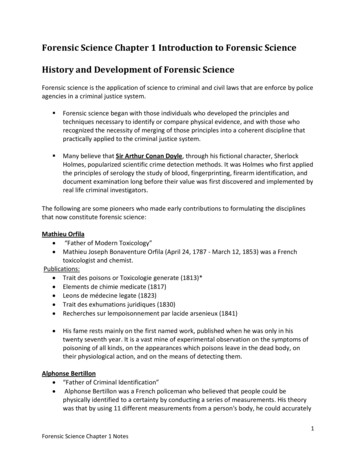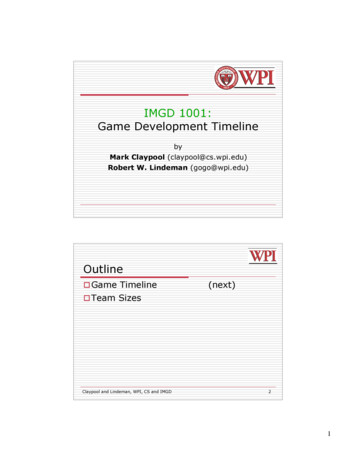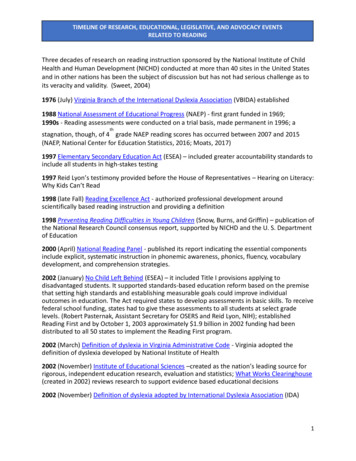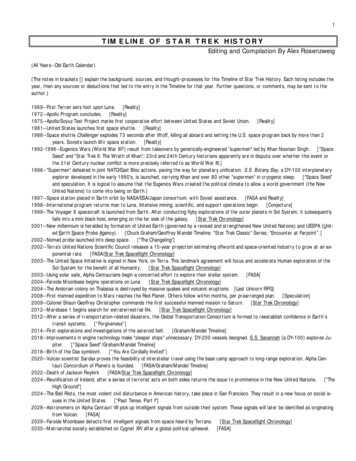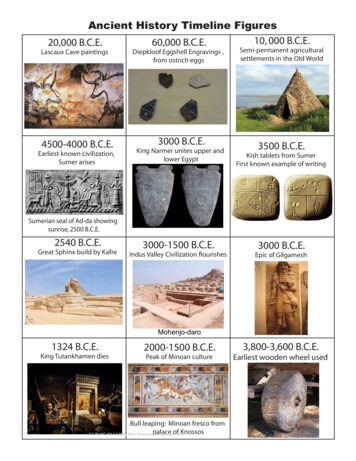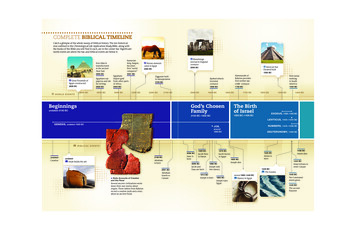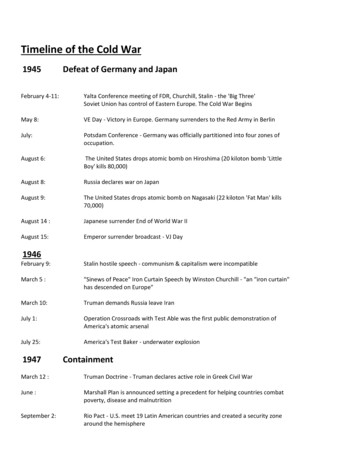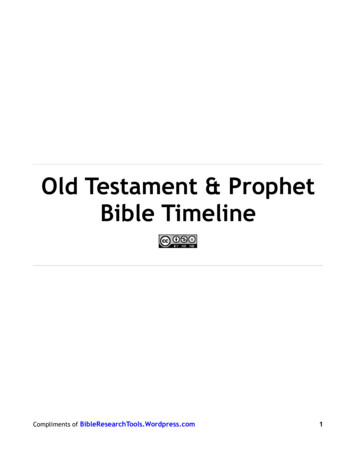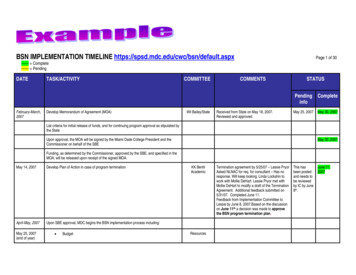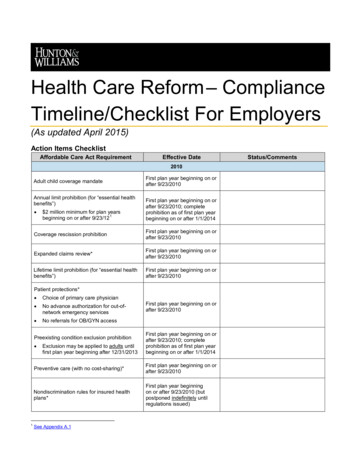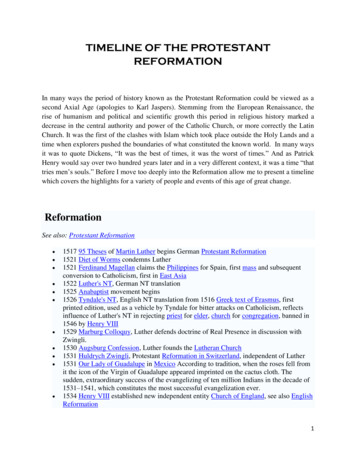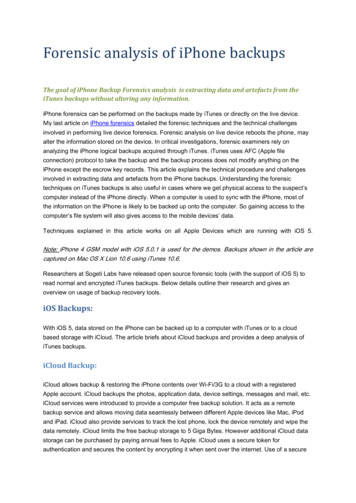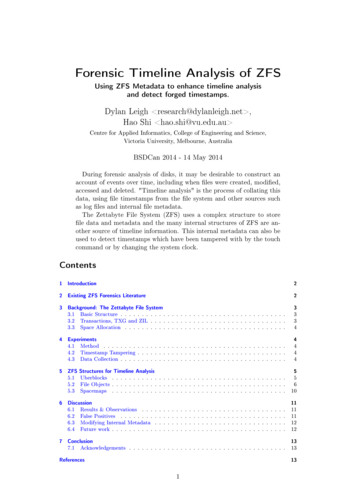
Transcription
Forensic Timeline Analysis of ZFSUsing ZFS Metadata to enhance timeline analysisand detect forged timestamps.Dylan Leigh research@dylanleigh.net ,Hao Shi hao.shi@vu.edu.au Centre for Applied Informatics, College of Engineering and Science,Victoria University, Melbourne, AustraliaBSDCan 2014 - 14 May 2014During forensic analysis of disks, it may be desirable to construct anaccount of events over time, including when les were created, modi ed,accessed and deleted. "Timeline analysis" is the process of collating thisdata, using le timestamps from the le system and other sources suchas log les and internal le metadata.The Zettabyte File System (ZFS) uses a complex structure to storele data and metadata and the many internal structures of ZFS are another source of timeline information. This internal metadata can also beused to detect timestamps which have been tampered with by the touchcommand or by changing the system clock.Contents1 Introduction22 Existing ZFS Forensics Literature23 Background: The Zettabyte File System34 Experiments45 ZFS Structures for Timeline Analysis53.1 Basic Structure . . . . . . . . . . . . . . . . . . . . . . . . . . . . . . . . . . . . . . .3.2 Transactions, TXG and ZIL . . . . . . . . . . . . . . . . . . . . . . . . . . . . . . . .3.3 Space Allocation . . . . . . . . . . . . . . . . . . . . . . . . . . . . . . . . . . . . . .4.1 Method . . . . . . . . . . . . . . . . . . . . . . . . . . . . . . . . . . . . . . . . . . .4.2 Timestamp Tampering . . . . . . . . . . . . . . . . . . . . . . . . . . . . . . . . . . .4.3 Data Collection . . . . . . . . . . . . . . . . . . . . . . . . . . . . . . . . . . . . . . .3344445.1 Uberblocks . . . . . . . . . . . . . . . . . . . . . . . . . . . . . . . . . . . . . . . . . 55.2 File Objects . . . . . . . . . . . . . . . . . . . . . . . . . . . . . . . . . . . . . . . . . 65.3 Spacemaps . . . . . . . . . . . . . . . . . . . . . . . . . . . . . . . . . . . . . . . . . 106 Discussion6.16.26.36.4Results & Observations . . .False Positives . . . . . . . .Modifying Internal MetadataFuture work . . . . . . . . . .11111112127 Conclusion13References137.1 Acknowledgements . . . . . . . . . . . . . . . . . . . . . . . . . . . . . . . . . . . . . 131
1 Introduction1 IntroductionIn computer forensics,timeline analysis is the collation of timestamps and other eventinformation into an account of what occurred on the computer. Event informationsuch as le timestamps, log les and web browser cache and history is collated intoa super-timeline [1], with events corroborated from multiple sources.The Zettabyte File System (ZFS)[2, 3], a relatively new and unusual lesystem,uses a novel pooled disk structure and hierarchical object based mechanism for storing les and metadata. Due to the unusual structure and operation of ZFS, manyexisting forensics tools and techniques cannot be used to analyse ZFS lesystems.No timeline analysis tools[1, 4] currently make use of ZFS internal metadata.Furthermore, there are few existing studies of ZFS forensics, none of which includean empirical analysis of timeline forensics. There are no established procedures orguidelines for forensic investigators, with the exception of data recovery and ndingknown data on a disk [5, 6].We have examined ZFS documentation, source code and le systems to determinewhich ZFS metadata can be useful for timeline analysis.Much of the metadatais a ected by the order in which the associated les were written to disk.Ouranalysis has discovered four techniques which can use this metadata to detect falsi edtimestamps, as well as one which provides extra timeline information.2 Existing ZFS Forensics LiteratureBeebe et al'sDigital Forensic Implications of ZFS[7] is an overview of the forensicdi erences between ZFS and more traditional le systems; in particular it outlinesmany forensic advantages and challenges of ZFS. Beebe identi es many propertiesof ZFS which may be useful to a forensic investigator, highlighting the opportunitiesfor recovery of data from multiple allocated and unallocated copies. However, it isbased on theoretical examination of the documentation and source code, noting that we have yet to verify all statements through our own direct observation and reverseengineering of on-disk behavior .Beebe also mentions ZFS forensics in [8], noting that many le systems not usedwith Microsoft and Apple products have recieved inadequate study; ZFS, UFS andReiserFS are mentioned as particular examples of le systems that deserve to bethe focus of more research .Data recovery on ZFS has been examined extensively by other researchers. MaxBruning'sOn Disk Data Walk[6] demonstrates how to access ZFS data on disk fromrst principles; Bruning has also demonstrated techniques for recovering deletedles[9].Li [5, 10] presents an enhancement to the ZDB lesystem debugger which allowsit to trace target data within ZFS media without mounting the le system. Finally,some ZFS anti-forensics techniques are examined by Cifuentes and Cano [11].2
3 Background: The Zettabyte File System3 Background: The Zettabyte File SystemA brief description of ZFS internals is provided here; for full details please consultThe Zettabyte File System [2], Sun Microsystems ZFS On DiskSpeci cation [12] and Bruning's ZFS On Disk Data Walk [6].Bonwick and Ahrens'ZFS stores all data and metadata within a tree of objects.Each reference toanother object can point to up to three identical copies of the target object, whichZFS spreads across multiple devices in the pool if possible to provide redundancy incase of disk failure. ZFS generates checksums on all objects and if any objects arefound to be corrupted, they are replaced with one of the redundant copies.3.1 Basic StructureA ZFS Pool contains one or more virtual devices ( vdev ), which may contain oneor more physical devices. Virtual devices may combine physical devices in a mirroror RAID-Z to ensure redundancy. Dedicated devices for cache, ZIL and hot sparesmay also be allocated to a pool.Each device contains an array of 128 Uberblocks ; only one of these is active atone time. The Uberblock array is duplicated 4 times in each vdev for redundancy.Each Uberblock contains a Block Pointer structure pointing to the root of theobject tree, the Meta Object Set . Apart from the metadata contained within theUberblock, all data and metadata is stored within the object tree, including internalmetadata such the free space maps and delete queues.Block Pointers connect all objects and data blocks and include forensically usefulmetadata including up to three pointers (for redundant copies of the object/data),transaction group ID (TXG) and checksum of the object or data they point to. WhereBlock Pointers need to refer to multiple blocks (e.g. if not enough contiguous spaceis available for the object), a tree of Indirect Blocks is used. Indirect blocks pointto blocks containing further Block Pointers, with the level zero leaf Block Pointerspointing to the actual data. Section 5.2.3 further discusses the forensic uses of BlockPointers.Each ZFS lesystem in a pool is contained within an object set, or Dataset . Eachpool may have up to 264Datasets; other types of datasets exist including snapshotsand clones. The Meta Object Set contains a directory which references all datasetsand their hierarchy (e.g. snapshot datasets depend upon the lesystem dataset theywere created from). Filesystem datasets may be mounted on the system directoryhierarchy independently; they contain several lesystem-speci c objects as well asle and directory objects. File objects are examined in detail in section 5.2.3.2 Transactions, TXG and ZILZFS uses a transactional copy-on-write method for all writes. Objects are never overwritten in place, instead a new tree is created from the bottom up, retaining existingpointers to unmodi ed objects, with the new root written to the next Uberblock inthe array.Transactions are collated in Transaction groups for committing to disk. Transaction groups are identi ed by a 64 bit transaction group ID (TXG), which is storedin all Block Pointers and some other structures written when the Transaction Groupis ushed.Transaction groups are ushed to disk every 5 seconds under normaloperation.Synchronous writes and other transactions which must be committed to stablestorage immediately are written to the ZFS Intent Log (ZIL). Transactions in the3
4 ExperimentsZIL are then written to a transaction group as usual, the ZIL records can thenbe discarded or overwritten.When recovering from a power failure, uncommittedtransactions in the ZIL are replayed. ZIL blocks may be stored on a dedicated deviceor allocated dynamically within the pool.3.3 Space AllocationEach ZFS virtual device is divided up into equal sized regions called metaslabs . Themetaslab selection algorithm prioritizes metaslabs with higher bandwidth (closer tothe outer region of the disk) and those with more free space, but de-prioritizes emptymetaslabs. A region within the metaslab is allocated to the object using a modi edrst- t algorithm.The location of free space within a ZFS disk is recorded in a space map object.Space maps are stored in a log-structured format - data is appended to them whendisk space is allocated or released. Space maps are condensed [13] when the systemdetects that there are many allocations and deallocations which cancel out.4 Experiments4.1 MethodIn our experiments, ZFS metadata was collected from our own systems and testsystems created for this project. Disk activity on the test systems was simulated usingdata obtained from surveys of activity on corporate network le storage [14, 15, 16].ZFS pools with 1,2,3,4,5,7 and 9 devices were created on the test systems, includingpool con gurations with all levels of Raid-Z, mirrors and mirror pairs as well as at pools where applicable, giving 22 di erent pool constructions. The test systems usedFreeBSD version 9.1-RELEASE with ZFS Pool version 28.4.2 Timestamp TamperingThree experiments were conducted for each pool: a control with no tampering, onewhere timestamps were altered by changing the system clock backwards one hourfor ten seconds, and one where the Unix touch command was used to alter themodi cation and access times of one le backwards by one hour.4.3 Data CollectionInternal data structures were collected every 30 minutes as well as before and afterall experiments, using the zdb (ZFS Debugger) command. Three types of metadatawere collected: All 128 Uberblocks from all virtual devices in the pool. zdb -P -uuu -l /dev/ device All Spacemaps for all Metaslabs in each virtual device. zdb -P -mmmmmm pool All objects and Block Pointers from with the dataset with simulated activity. zdb -P -dddddd -bbbbbb poolname / dataset-name The Quick Reference [17] contains further example commands for ZFS timelineforensics.4
5 ZFS Structures for Timeline AnalysisListing 1: Example Uberblock dump from ZDB.Uberblock [72].Uberblock [73]magic 0000000000 bab10cversion 28txg 1737guid sum 4420604878723568201timestamp 1382428544 UTC Tue Oct 22 18:55:44 2013rootbp DVA [0] 0:3 e0c000 :200 DVA [1] 1:3 f57200 :200 DVA[2] 2:3593 a00 :200 [ L0 DMU objset ] fletcher4 lzjb LEcontiguous unique triple size 800 L /200 P birth 1737 L /1737 Pfill 42 cksum 15 ffed59a7 :7 e9c9c594b0 :17 c4c7cb7a7eb :318e5de89d442aUberblock [74].5 ZFS Structures for Timeline Analysis5.1 UberblocksAn example Uberblock dump from ZDB is shown in Listing 1. The most useful entriesfor forensic investigators are the TXG and timestamp; this provides one method tolink a TXG to the time it was written. This can be used to verify le timetamps anddetect false ones. Where a le is modi ed with the touch command, the timestampon the le will not match the timestamp in the Uberblock with the same transactiongroup (TXG).Consecutive uberblocks contain increasing TXG and timestamps (except for thehighest TXG where the array wraps around). Where the system clock was changed,the corresponding changes in the uberblock timestamps before and after the clockchanges show that tampering occurred.Uberblocks could potentially be used to access previous version of the object tree,however they are quickly overwritten (see Disadvantages below) so this facility isonly useful when they can be collected immediately after tampering has occurred.Other than this, uberblocks do not provide any extra information beyond the letimestamps.In 50% of all experiments involving tampering we were successfully able to usean Uberblock to detect a falsi ed le timestamp. However, this was only possiblebecause data was collected every 30 minutes during the experiments; at the end ofthe simulation the relevant uberblocks were already overwritten.5.1.1 Uberblocks: DisadvantagesUberblocks are the simplest metadata for an attacker to tamper with as they are atthe top of the hash tree; if modi ed the attacker only has to change the uberblock'sinternal checksum to match.The most serious disadvantage of Uberblocks for forensic use is that for mostpools they last only 10.6 minutes under a continuous writing load. This is due toZFS typically writing a new Uberblock every 5 seconds (5 128 640 seconds).In75% of experiments, the oldest Uberblock in the array of 128 was between 634 and636 seconds old.Pools with 4 or more top level virtual devices (i.e. 4 or more disks and a at 5
5 ZFS Structures for Timeline Analysis4-9 Disks, Mirror/Raid-Z4-9 Disks, No Redundancy1-3 Disks (all con gs)0200040006000800010000Figure 1: Time in seconds between oldest and newest Uberblock, for di erent poolcon gurations.pool with no redundancy) consistently had a signi cantly longer period between theoldest and newest Uberblock in the pool; between 1475 and 8609 seconds (median4018). With more than three devices, some writes may not a ect all devices, so anew uberblock will not always be written to all of them for each TXG. Pools usingRAID-Z or mirroring are less a ected as writes are likely to a ect all devices in amore redundant pool.Figure 1 plots the di erences between di erent types of pool con guration. Poolswith less than 4 disks all had a uberblock period of 636 seconds or less, as did mostpools with 4 or more disks which used a mirror or RAID-Z con guration.Due to the short lifespan of Uberblocks they are most useful in a dawn raid scenario, where a system is siezed immediately after a suspect may have been deletingor modifying les. In this case they could be used to access previous version of theobject tree and determine recent changes.5.2 File ObjectsAll objects and Block Pointers associated with a dataset may be extracted usingZDB's-band-doptions. We have only examined lesystem datasets at this stage.A sample le object is shown in Listing 2.File objects contain several attributes which are useful for verifying timestamps; inparticular, the gen TXG and the Object Number which are related to the creationtime of the object. Block pointer TXG values in the Block Pointers which point tothe le data can also be used to detect falsi ed timestamps, and in some cases BlockPointers to previously written le data segments may also be used to obtain the timeof those modi cations.5.2.1 Object NumberAll objects in a dataset have a 64 bit object number , used as an internal identi erfor ZFS. As new object numbers are generated in locally increasing order, they arerelated to the order of creation of objects, and can therefore be used to detect objectswith a falsi ed creation time.In all experiments involving a falsi ed creation time, the object number of thea ected les were out of order; this provides a simple method to detect false creationtimes.Figure 2 (left) shows a plot of object number vs creation time from anexperiment where the system clock was adjusted one hour backwards to alter letimestamps; the outliers above the line indicate les with false creation times.Object numbers may be reused when ZFS detects a large range of unused numbers (e.g. when many les are deleted); this did not occur during our experimentsand further study is required to determine how often numbers are reused duringproduction conditions and how this would a ect forensic use of object numbers.6
5 ZFS Structures for Timeline AnalysisListing 2: Example File Object dump from ZDBObject lvliblkdblk154171 16384 67072 inherit ) ( Z inherit )dsize67072lsize67072% full100.00typeZFS plain file ( K168bonus System attributesdnode flags : USED BYTES USERUSED ACCOUNTEDdnode maxblkid : 0path/1382428539 - to -2147483647 - reps -0uid0gid0atimeTue Oct 22 17:55:40 2013mtimeTue Oct 22 17:55:40 2013ctimeTue Oct 22 17:55:40 2013crtime Tue Oct 22 17:55:40 2013gen1737mode100644size66566parent 4links1pflags 40800000004Indirect blocks :0 L0 DVA [0] 2:353 c200 :10600 [ L0 ZFS plain file ]fletcher4 uncompressed LE contiguous unique singlesize 10600 L /10600 P birth 1737 L /1737 P fill 1 cksum 1e970f0f68f0 :3 f178f0ed3b3b88 :1 c0a9b8bd4c82800 :eb83cbb696eca800segment [0000000000000000 , 0000000000010600) size67072As object numbers are not a ected by modi cations to the le, they cannot be usedto detect falsi ed modi cation time, unless the modi cation time is altered to beforethe le was created. They cannot be used to provide any extra event information toforensic investigation (beyond verifying the le creation time).5.2.2 Object Generation TXGAll lesystem objects also store the transaction group ID in which they were generated (this is the gen attribute in Listing 2).Similar to object numbers, as they increase with the order of creation of objectsthey can also be used to detect objects with falsi ed creation time. In all experimentsinvolving a falsi ed creation time, the generation TXG was out of order. The rightplot in Figure 2 shows a plot of Generation TXG vs creation time; again the outliersabove the line are from the same les which were created when the system clock wasreverted by one hour. Although covering the same three hours the TXG graph risesevenly over time as TXG are ushed to disk at a constant rate, whereas le objectsare created at a variable rate.Likewise, they cannot be used to detect falsi ed modi cation time unless themodi cation time is altered to before the le was created, and no not provide anyextra information beyond corroborating the creation time.7
5 ZFS Structures for Timeline AnalysisFigure 2: Object number (left) and generation TXG (right) vs. creation time, fromle objects in an experiment with false creation times.Time values aretime t (seconds since Unix epoch).5.2.3 Block Pointer TXGUnless empty, each le object dumped from ZDB contains at least one Block Pointerpointing to the le data. Each Block Pointer contains the TXG in which the pointerwas written. This is the most useful metadata discovered so far for detecting falsi edtimestamps, and can even be used to determine past modi cation times in some cases.As TXG increase with time, the order of writes can be veri ed by comparingmodi cation times with the le's most recent Block Pointer TXG. If a le containsmultiple Block Pointers, the highest level pointer in the Indirect Block(s) will containthe most recent TXG. Figure 3 (left) shows Block Pointer TXG plotted againstmodi cation time.Allowing a 5 second window for the ushing of each TXG to disk, any out-oforder TXG/modi cation time pairs indicate the timestamp may be falsi ed. In allexperiments inolving tampering, comparison of Block Pointer TXG between les wassuccessful in detecting it.Determining Past Modi cation TimesListing 3 shows an example of a large le with two segments written during di erenttransactions. The le object points to one level 1 Indirect Block containing two level0 leaf Block Pointers, which point to the le data. The data in the r
an empirical analysis of timeline forensics. There are no established procedures or guidelines for forensic investigators, with the exception of data recovery and nding known data on a disk [5,6 ]. We have examined ZFS documentation, source code and le systems to determine which ZFS metadata can be useful for
